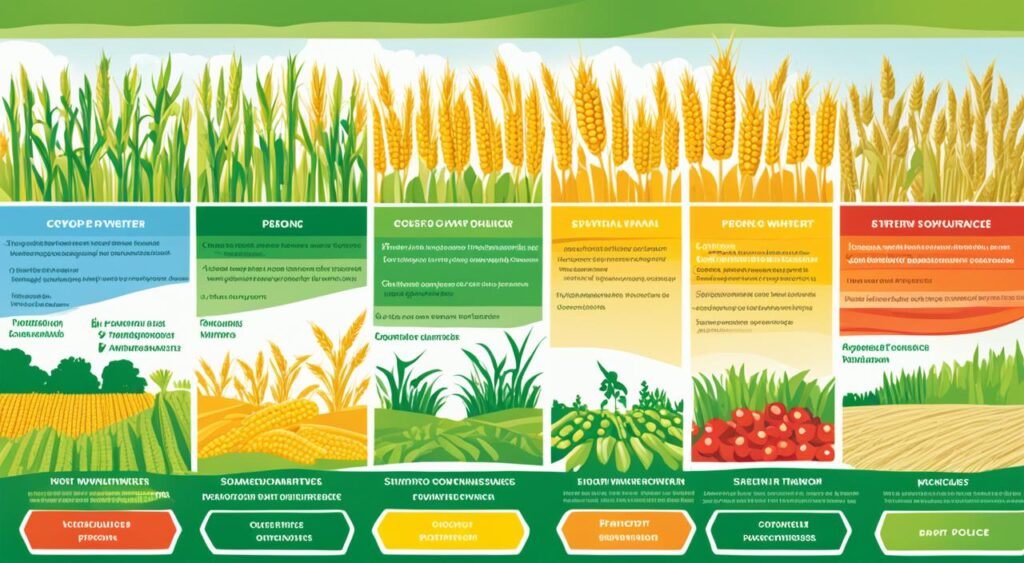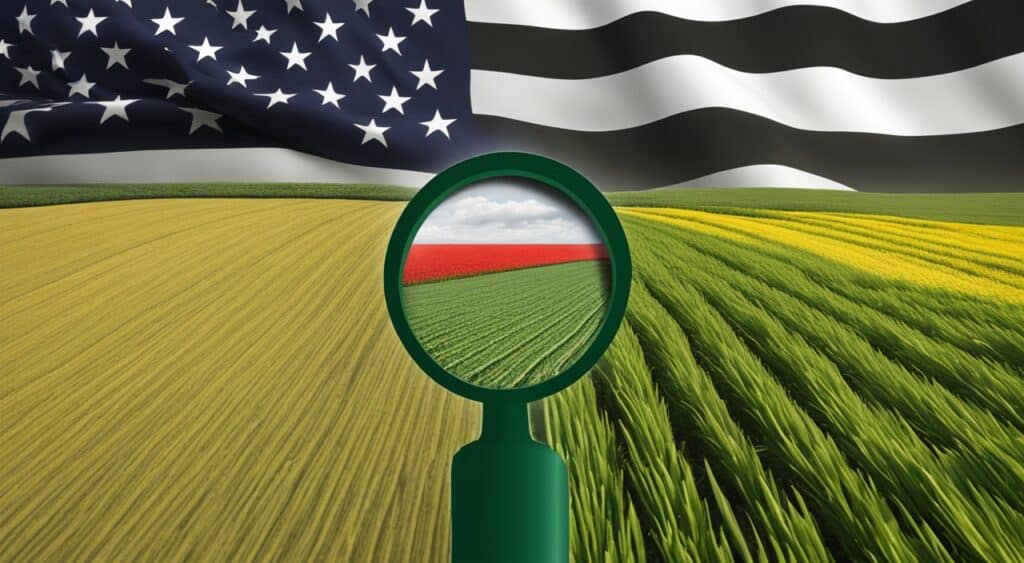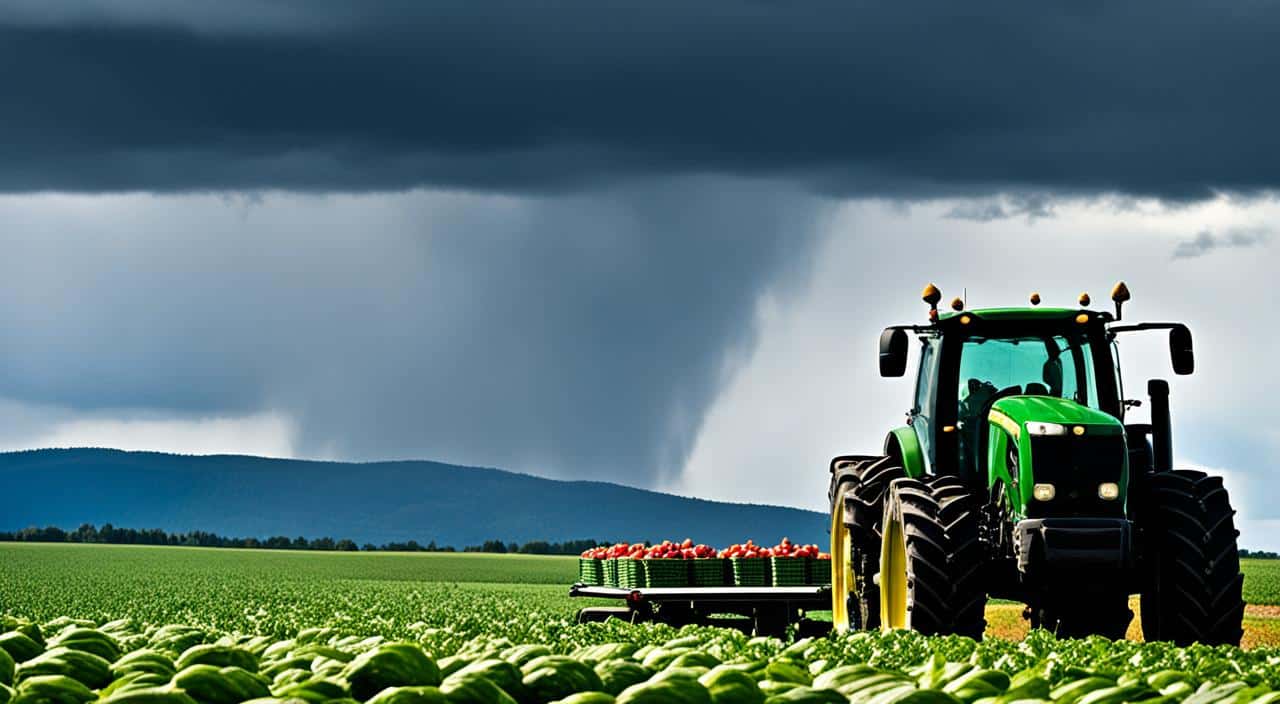The Federal Crop Insurance Program (FCIP) helps farmers in the U.S. manage risks. It offers coverage against many issues, from weather to market changes. This program includes over 134 crops, from common ones like corn and soybeans to special crops and livestock.
Since the year 2000, more and more farmers have joined the FCIP. The area covered by insurance has almost doubled, from 206 million acres to 494 million in 2022. One reason for this is the addition of insurance for Pasture, Rangeland, and Forage (PRF) in 2022. PRF made up nearly half of the insured land.
The FCIP works together with private insurance companies. These Approved Insurance Providers (AIPs) sell the policies and help the farmers. The government helps by paying part of the premiums and the insurance companies’ costs through the SRA.
Farmers and ranchers can buy different types of crop insurance to protect their business. They can choose plans that match their risks and needs. Options include protection for a crop’s yield, its revenue, or protection for a certain area.
Key Takeaways
- The Federal Crop Insurance Program (FCIP) gives financial protection to U.S. farmers against many risks.
- More than 134 crops are covered, from big ones to unique crops.
- In recent years, more farmers have joined, with insured land growing to 494 million acres in 2022.
- The FCIP is run with private companies, but supported by the government to lower costs for farmers.
- Farmers can pick from several insurance types to safeguard their farms in the best way.
Introduction to Crop Insurance
Crop insurance is vital for farmers and ranchers in the US. It protects against lower crop yields and revenue. These can happen because of drought, too much rain, frost, diseases, and changing prices. The Federal Crop Insurance Corporation (FCIC) was formed in 1938. It aimed to support agriculture after the Great Depression and the Dust Bowl.
Definition and Purpose of Crop Insurance
Crop insurance is a tool to reduce financial risks for farmers. It helps with natural disasters and bad weather. When crops fail, it pays out, keeping farmers afloat.
History of Crop Insurance in the United States
Crop insurance began with the Agricultural Adjustment Act of 1938. This act led to the Federal Crop Insurance Corporation (FCIC). It aimed to help farming recover from the Great Depression and the Dust Bowl. Since then, crop insurance has grown through new laws. It is now critical for the agriculture safety net.
Federal Crop Insurance Program (FCIP)
The Federal Crop Insurance Program (FCIP) is vital for American agriculture. It supports 134 different crops. The program is managed by the USDA’s Risk Management Agency (RMA). It aims to protect farmers from financial loss due to bad events.
Overview of FCIP
This program is for farmers and ranchers to handle production risks. Producers can buy insurance for their crops. This includes but isn’t limited to barley, corn, cotton, and others like flax and grapefruit.
Eligibility Requirements for FCIP
To join the FCIP, producers must meet certain conditions set by the RMA. They should have a stake in the crops. Also, they must keep records of their land and what they grow.
They have to follow all program rules. The FCIP is open to farmers all over the U.S. It covers many types of lands and crops.
Crops Covered by FCIP
The FCIP covers a big variety of crops. This includes well-known ones like barley and corn. It also includes special crops like flax and grapefruit.
Types of Crop Insurance Policies

The Federal Crop Insurance Program (FCIP) includes various types of coverage. It mainly includes individual and area- or index-based policies. These help farmers protect against risks based on their unique situations and locations. This is for those working in agriculture across the U.S.
Individual Yield Protection Policies
The FCIP offers individual yield protection policies, also called yield-based policies. They pay when a farmer’s actual yield is lower than their guaranteed yield. The guarantee is often based on past average yields. This way, each farmer protects their particular farm from low yield losses.
Individual Revenue Protection Policies
Individual revenue protection policies, known as revenue-based policies, protect against low revenue. They cover farmers if their actual revenue is less than the guaranteed revenue. The guarantee is the highest between the projected price or the harvest price times the yield. Farmers use this to manage risks from both yield and price changes.
Area and Index-based Policies
There are also area-based policies and index-based policies. These policies work differently. They use an area’s average yields or revenues to calculate payments. Even though they are less personalized, they can be cheaper and protect against big regional losses.
The right insurance policy depends on a farmer’s risk management and financial situation. The FCIP’s variety of policies let farmers pick what suits them best. This is how it helps farmers across the country deal with the many risks in farming.
Coverage Levels and Premium Subsidies

The Federal Crop Insurance Program lets producers pick from different coverage levels. These levels show the amount insured compared to what could be insured. This choice helps farmers adjust their insurance to fit their needs. In 2022, coverage reached 75%, showing the program is more important for farmers than ever.
The program also gives producers a big break on costs, known as premium subsidies. These are paid by the government. They make buying crop insurance cheaper, which helps many farmers. With lower costs, more farmers can get the level of insurance they need to protect their farms.
| Coverage Level | Premium Subsidy |
|---|---|
| 50% | 67% |
| 55% | 64% |
| 60% | 64% |
| 65% | 59% |
| 70% | 59% |
| 75% | 55% |
| 80% | 48% |
| 85% | 38% |
This mix of insurance choices and deals on prices has made the FCIP work well. It lets farmers get good insurance without costing too much. The program’s mix of public and private effort keeps it strong for farmers and ranchers across the country.
Role of Private Insurance Providers

The Federal Crop Insurance Program (FCIP) runs with the help of private companies, called Approved Insurance Providers (AIPs). These firms are critical in the sale and service of insurance policies. They work with the federal government to offer insurance to farmers nationwide. This partnership ensures agricultural producers can protect their crops.
Approved Insurance Providers (AIPs)
These AIPs are insurance firms given the green light by the USDA’s Risk Management Agency (RMA). They’re allowed to provide and manage crop insurance products. The private insurance providers handle everything from selling policies to dealing with claims and helping customers. Their knowledge and reach make crop insurance widely available to farmers and ranchers everywhere.
Standard Reinsurance Agreement (SRA)
The federal government works with these private firms under the Standard Reinsurance Agreement (SRA). This deal sets out how the government will help these firms share the financial risks of the program. With the SRA, the government boosts the farmers’ premium payments and the AIPs’ operating costs. This helps keep the collaboration between the public and private sectors strong and lasting.
Crop Insurance
Crop insurance is vital for farmers and ranchers in the U.S. It guards against drops in crop yields and income. This can happen due to drought, too much rain, freezing, diseases, and price changes. It shifts these risks from the agricultural producers to others. Thus, they can protect their farms and stay afloat against nature’s sudden hits.
Importance of Crop Insurance for Farmers and Ranchers
For farmers and ranchers, it’s a key part of keeping their risk low. It acts as a safety cushion against things like hail, fire, and other natural disasters. With it, they get money back when they face losses. This helps them keep going and use help like price support programs to bounce back.
Differences between Federally Subsidized and Private Crop Insurance
The federal crop insurance program has support offerings. And there are private crop insurance options too. Choosing between them depends on what each farmer or rancher needs. This means looking at what risks they have and what’s available and affordable where they are.
Recent Legislative Changes

In the past decade, the Federal crop insurance program has seen big changes. This was due to the 2014 Farm Bill and the 2018 Farm Bill. These bills brought new programs and improved the crop insurance system.
The 2014 Farm Bill
The 2014 Farm Bill made the Federal Crop Insurance Program even stronger. It kept the program as a vital support for farmers. New tools like the SCO and the STAX were added.
These changes were particularly good for cotton and special crop producers. They could buy extra coverage to protect their incomes. The bill also helped organic farmers get better access to crop insurance.
The 2018 Farm Bill
The 2018 Farm Bill continued to improve the crop insurance system. It added industrial hemp as an insurable crop. This was a big step forward. The bill also focused on helping veteran farmers.
More money was put into programs that support rural development and bioenergy. This would help the agriculture sector and rural areas grow.
Both bills were important for many different kinds of farmers. They ensured the insurance program kept up with the times. This way, it can still help all kinds of farm businesses stay strong.
Causes of Crop Losses and Indemnities

Many things can affect how much money Federal Crop Insurance Program pays out. The biggest factors are how much producers want the insurance, if there are lots of natural disasters like drought or too much rain, and the changing value of crops.
Major Causes of Crop Losses
Disasters and extreme weather events are top reasons why crops fail. They cause things like drought, too much rain, and flooding. These events can hurt how much crops grow and what farmers earn. That’s why the Federal Crop Insurance Program steps in to help.
Indemnity Payments and Loss Ratios
The loss ratios under the Federal Crop Insurance Program change a lot. They show how much money the program pays out compared to crop values. When there are many natural disasters, the loss ratios are bigger. This means the program is helping a lot of farmers. Keeping an eye on these ratios is key. It helps make sure the insurance program can keep helping farmers over time.
Program Costs and Funding
The cost of the Federal Crop Insurance Program has gone up with more people taking part. Premium subsidies are a big part of the program’s cost, reaching $11.98 billion in 2022. This program works with private companies under a Standard Reinsurance Agreement (SRA). It helps them with costs and provides gains, affecting the total expenses.
Premium Subsidies
Premium subsidies are vital in making the Federal Crop Insurance Program work for farmers. They are provided by the government to help make insurance more affordable. In 2022, the government paid for about 62% of the insurance costs, helping more farmers join.
Administrative and Operating Costs
Aside from subsidies, the costs also cover the expenses of the companies selling the insurance (AIPs). The SRA helps with these costs too. These include day-to-day and operation costs, a key part of keeping the program running smoothly.
Also Read: Protecting Your Future: The Importance Of Safety Insurance
Conclusion
The Federal Crop Insurance Program (FCIP) is crucial for farmers in the U.S. It has changed a lot over the years. Many new laws and insurance types have made it better for farmers.
This program works with private insurance companies. That makes it easier for farmers to join. Also, the government helps by paying part of the insurance cost.
The FCIP still has room to grow. Policymakers and people in the industry need to watch how it’s doing. They need to keep it both helpful and affordable for farmers.
FAQs
Q: Who is eligible for crop insurance in the USA?
A: Crop insurance in the USA is available to producers with a share in the crop’s risk and revenue, including farmers, ranchers, and growers.
Q: What is crop revenue insurance?
A: Crop revenue insurance is an insurance product that provides protection against declines in crop revenue or income due to natural perils or price fluctuations.
Q: What is the difference between crop-hail insurance and multi-peril crop insurance?
A: Crop-hail insurance provides coverage for hail damage specifically, while multi-peril crop insurance offers a broader range of coverage for various perils that can affect crops.
Q: How does crop insurance work?
A: Crop insurance works by offering financial protection to producers against losses due to natural disasters, such as droughts, floods, or pests, impacting their crop yields or revenues.
Q: What types of crop insurance plans are available?
A: There are different crop insurance plans available, including revenue insurance, yield insurance, and whole farm revenue protection, to cater to the specific needs of producers.
Q: How can farmers purchase crop insurance?
A: Farmers can purchase crop insurance through approved crop insurance agents who sell and service crop insurance products on behalf of private insurers participating in the federal crop insurance program.
Q: Is crop insurance subsidized in the USA?
A: Yes, crop insurance premiums are subsidized by the government to make this risk management tool more affordable for producers, ensuring a strong farm safety net.
Source Links
- https://www.rma.usda.gov/Federal-Crop-Insurance-Corporation
- https://www.ers.usda.gov/topics/farm-practices-management/risk-management/crop-insurance-at-a-glance/
- https://content.naic.org/cipr-topics/crop-insurance





